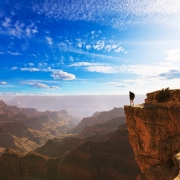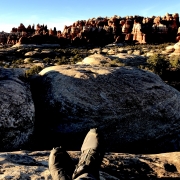The Art of Exuberant Aging | Healthy Aging Series: S10 E8
“The Swedish Art of Aging Exuberantly,” by Margareta Magnusson
I’m sitting at Muhammad Ali international airport, drinking a fancy drink from Starbucks, as I head to Colorado to visit my son, daughter-in-law, and granddaughters.
After a five-day visit with my family, I’ll meet my wife at the Denver Airport, and then we’ll fly to Phoenix and eventually end up at Grand Canyon National Park.
My Feats of Strength
I’ve been training for a Rim to River to Rim hike in one day. That means 18 miles, and 10,000+/- feet of elevation. It should take about 10 hours. I’ll start at 4:30 AM and hopefully finish at 2:30 PM. When I’m done, I get a kiss from my wife. A high five, and then lots of food, a nap, and a beer. Repeat next year.
I’ve been training. I have a 45-pound backpack in my jeep, and I’ve been doing hill repeats for the past six weeks. I’ve spent lots of time in the Jefferson Memorial Forests and lots of miles on trails. I stopped my weight loss diet and I focused on fueling my body. You shouldn’t train for this type of endurance feat and try to lose weight at the same time.
I’m ready. I’ll maybe hike the Manitou Incline this Sunday as a prep hike. It’s a 1-mile trail that gains 2000 feet of elevation. It’s up the side of a mountain. I should be able to get to the top in about 75 minutes. Mind you, that’s what it takes me to quickly walk 5 miles.
Exuberant Aging
Is this exuberant aging? Maybe. I’m 67 years old. Some would say I’m aging exuberantly. I recently read, “The Swedish Art of Aging Exuberantly,” by Margareta Magnusson. It’s her follow up to “The Gentle Art of Swedish Death Cleaning,” which I wrote about last year in this very blog. So, what’s her take on exuberant aging?
First, Margareta is Swedish and in her mid-80s. She’s not out doing a Rim to River to Rim Grand Canyon Hikes. She’s not cycling 50 to 100 miles on the weekend. Her definition of exuberance is a little different from mine. I would’ve suggested getting a personal trainer when she was in her 60s to help her with her stability and mobility. That might have prevented the fall and hospitalization and rehab that follow a fall. But despite her physical vulnerabilities (a serious fall in her 80’s), I loved her spirit and attitude about life, and after all, exuberant living is not just about running half marathons and 5K‘s. Exuberant Aging is the ability to maintain a youthful spirit despite the loss of youthfulness. It is a physical thing, but mostly, it’s a refusal to mentally give in to the aging process.
So, here are my takeaways about exuberant aging:
1. “Never give up never surrender!” Dr. Lazarus from Galaxy Quest. I think this is what Magnusson would say. Margareta lived exuberantly by not throwing in the towel, and by keeping her head in the game.
First, a few things about my aging process:
I see myself slowing down, and I mean that literally. My times are getting slower doing the same distance. My recovery time is getting longer. Whereas, it might’ve just taken one day of recovery from a six- or 10-mile hike, I now need to take sometimes three days to recover. My energy levels are dropping, ergo, I’ve focused more on energy conservation. I can’t handle the same volume levels in weight training that I did 10 or 20 years ago. I do less sets and reps and never heavy weights. Magnusson writes, “I don’t have as much energy now, but I help seniors learn how to maintain and use the Internet.” Magnusson isn’t doing any half marathons, but she does her best to stay as active as she possibly can. “Right now, spring is around the corner,“ she writes. “I look out the window and long to get started with my gardening. When you are my age, it is important to fill your mind and days with stuff to do; planning, helping, thinking, and moving around as much as you can.” “Some of that time,” she concludes, “should be spent laughing.” “It is never too late to do anything,” she writes, “unless it really is too late, and you are dead.” I love it.
It is my plan to keep doing the Canyon until I can’t, to keep hiking those 10-to-12-mile hikes in the Jefferson Forest until I’m not able to, to keep learning, and to never give up, to never surrender.
2. Magnusson is aging exuberantly by embracing the negatives in aging. “There seems to be no choice,“ she suggests “then to see each and every burden, every nuisance, every pain, as something that is also dear, something that I must find a way to cherish.“
What do we embrace?
We embrace the loss of memory, loss of vision, and hearing, and the loss of friends, family, and sometimes partners.
We embrace the annoyances of aging like being treated as if we’re invisible and of needing to repeat ourselves all the time.
We embrace the problem of waking up at 2, 3, or 4 AM.
We embrace getting lab work that reflects a decline in our kidney function, or high potassium levels, or rising PSA.
We embrace the lower back pain, or hip pain, or knee pain.
We “step into” our fears, into our losses, and into our pain.
3. Magnuson practices, reflecting or “airing out memories,” to live or age exuberantly. Reflecting can energize us.
“Memory helps us retrieve events with people,” she writes, “people we want to remember. But my closest ones are always within and next to me, and I don’t need to think about things we did or said. Some people just become part of you and that feels comforting.” Much of Magnusson’s book is reflecting about her husband, her children, and her moves around the world. Remembering and reflecting seemed to give her energy to keep living and aging exuberantly. Throughout our lives we do, in non-clinical terms, something we call stuffing. It has been called compartmentalizing as well, and it can suck the energy from our lives. We need to air out everything, because if we don’t air that stuff out, we do what depth therapists call compensation. It’s the energy that we use to keep unpleasant thoughts and memories in our shadow. This is not good, so airing out and reflecting, is very helpful and beneficial toward aging exuberantly.
4. Another way that Magnusson energizes herself and helps her age exuberantly is by giving back. Magnussen suggests that we have two options as we get older:
Giving up or Giving Back
The symbol of giving up is the rocking chair. “The rocking chair is our most dangerous invention,” she warns. “More people die from unhealthy conditions that are exacerbated by sitting too much than anything else.” Giving back is the remedy for the rocking chair.
Magnusson began volunteering at a children’s library, and it energized her. She surrounded herself with younger people. “Happiness,” she explains, “is being surrounded by the young. My father knew it. I know it. And if you’re 80 years old, even a 70-year-old is younger than you.”
If you believe that you have learned anything in the aging process, if you have something that young people would benefit from hearing about or seeing, if you have learned how to navigate life and have learned how to become your authentic self, then infecting others with this wisdom will benefit them and energize you.
I don’t purposely seek out younger people, but I have several in my life. Maybe they’re drawn to a person that wants to give back.
My Version of Aging Exuberantly
These are a few of the things that energized Magnusson and lead to her exuberant aging. There are more in her book. I suggest reading it.
Now, I’ll share a few things that energize me. Keep in mind I am 20 years younger than Magnusson.
First, setting fitness goals energizes me. I don’t run marathons or cycle across states anymore, but I schedule challenging hikes and climbs throughout my year. Then, in the months leading up to the challenge, I do as much as I can to prepare for that challenge. I shared earlier my upcoming hike into the Grand Canyon. There will come a day that I am not able to do the Canyon or climb Fourteeners in Colorado, but I will hopefully still be able to hike in the Jefferson Memorial Forest, or cycle through the Parklands, and that will energize me as well.
Second, solitude energizes me. I love hiking by myself. Don’t get me wrong, I love the times that I’m with hiking and backpacking partners. Being in the forest with others adds a good dimension to the hike, but going solo allows me to be in my head in a good way, and I feel energized when I am done. In the hiking world, there is something called “hiker dissociation.” It happens when you’re on a one- or two-hour hike and then you stop thinking, or purposely thinking. You turn off your ego and allow thoughts, feelings, memories, or ideas to come to consciousness. Some people describe it as meditation. I don’t. It’s more like shadow work or active imagination as suggested by Carl Jung.
Sometimes I invite shadow figures to hike with me like my mom and dad, but mostly I let happen what happens. And I feel energized.
Third, art energizes me! More specifically, I mean being creative energizes me, and even more specifically, writing energizes me. I’ve been writing blogs for the past four years. I’ve been on again off again, and I can tell you that my psychic energy is up when I am “on again.” This summer I’m going to focus on personal essays. I’m getting excited about the process.
I love 70s music. I have reacquainted myself with Edgar Winter. While I was building a 70s playlist for an upcoming hike, I stumbled onto a song written by him in 1971 called, “Dying to Live.“ I’m writing a blog on it as we speak. Again, I am energized by music.
Fourth, people energize me! I am by nature an introvert. Yep, I see some of you shaking your head, but it’s true. Having said that, I love spending time with my wife, my sons, and my extended family. They energize me. Being a therapist energizes me.
What Energizes You?
Exuberant aging is a personal thing. It changes as we age. Our past determines what energizes us, as well as our culture. I think Magnusson has mapped out several timeless practices that can help anyone, anywhere, and at any age live exuberantly.
The rest is up to you.













